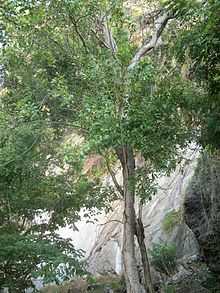Schinopsis brasiliensis
From Wikipedia, the free encyclopedia
| Schinopsis brasiliensis | |
|---|---|
 | |
| Scientific classification | |
| Kingdom: | Plantae |
| (unranked): | Angiosperms |
| (unranked): | Eudicots |
| (unranked): | Rosids |
| Order: | Sapindales |
| Family: | Anacardiaceae |
| Genus: | Schinopsis |
| Species: | S. brasiliensis |
| Binomial name | |
| Schinopsis brasiliensis Engl. | |
Schinopsis brasiliensis is a species of flowering plant in the cashew family known by the common names baraúna or braúna,[1] quebracho, and chamacoco.[2]
This species is endemic to Brazil,[2] where it is a component of the Caatinga.[3]
The tree can grow up to 12 meters tall with a trunk diameter of 60 centimeters.[4]
This tree has a hard, sturdy wood which is used in construction.[1][5] Because of its overexploitation for this purpose, the tree is considered an endangered species.[1]
Two species of mite have been noted to live on this tree, Calacarus torulus and Shevtchenkella schinopsidis.[5]
| Wikimedia Commons has media related to Schinopsis brasiliensis. |
References
- ↑ 1.0 1.1 1.2 Cardoso, M. P., et al. (2005). A new alkyl phenol from Schinopsis brasiliensis. Natural Product Research 19(5) 431-33.
- ↑ 2.0 2.1 Saraiva, A. M., et al. (2011). In vitro evaluation of antioxidant, antimicrobial and toxicity properties of extracts of Schinopsis brasiliensis Engl. (Anacardiaceae). African Journal of Pharmacy and Pharmacology 5(14) 1724-32.
- ↑ Dantas, B. F., et al. (2008). Biochemical changes during imbibition of Schinopsis brasiliensis Engl. seeds. Revista Brasileira de Sementes 30(2) 214-19.
- ↑ Saraiva, A. M., et al. Quantitative analysis of Schinopsis brasiliensis Engl. extract when incorporated into oil-in-water microemulsion.
This article is issued from Wikipedia. The text is available under the Creative Commons Attribution/Share Alike; additional terms may apply for the media files.